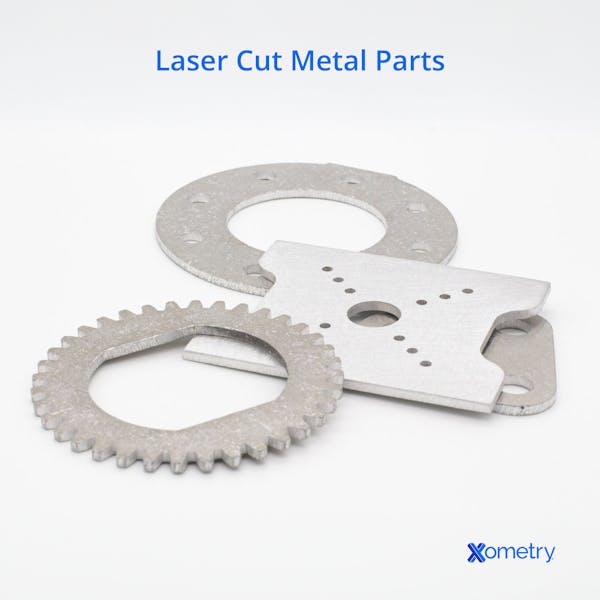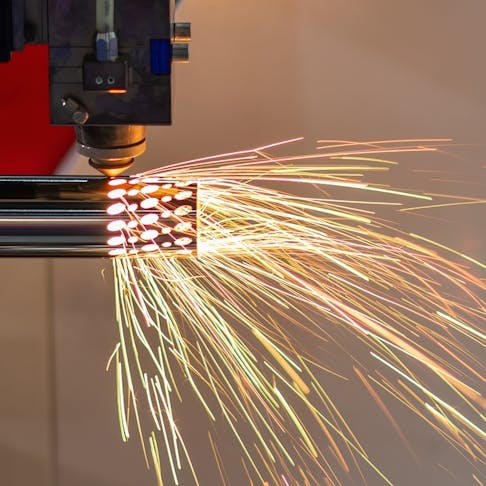Many stainless steel grades can be laser-cut efficiently and with high accuracy, provided the correct equipment and process parameters are used. Laser cutting offers various advantages over more traditional approaches — it reduces the risk of work hardening, introduces minimal heat-affected zones (HAZ), and often eliminates the need for post-processing. However, cutting stainless steel requires proper understanding of the material's properties, adherence to best practices, and the use of high-performance laser systems.
This article serves as a primer on best practices for laser cutting stainless steel and highlights how to avoid common errors.
What Is Stainless Steel?
Stainless steel is a broad term for austenitic, ferritic, precipitation, martensitic, and duplex (those with both austenitic and martensitic components) alloys. These alloys contain iron, carbon, chromium, and a range of other metallic alloying agents such as nickel, molybdenum, copper, niobium, titanium, and aluminum. Intentional additions can also be non-metallic, such as silicon, carbon, and sulfur.
The result is a spectrum of properties. Some alloys are strongly magnetic, while others are only weakly so or entirely non-magnetic. Some such steels are easy to work-harden, while others barely change. And though “stainless steel” is rhetorically synonymous with corrosion resistance, some versions do not fare well on that front.
What Are the Types of Laser-Cuttable Stainless Steel?
All stainless steel alloys can be laser-cut given the proper machine settings, sufficient power, and the right controlled atmosphere. In general, the types of cuttable stainless steel are:
- Austenitic Stainless Steel: These steels have a face-centered cubic (FCC) crystal structure. They cannot be hardened by heat treatment and are typically non-magnetic in the annealed condition. The 300 series (e.g., 304, 316) derives its austenitic structure from high nickel content, while the 200 series uses manganese and nitrogen to stabilize the structure. Austenitic stainless steels are highly corrosion-resistant and are prone to work hardening, which can affect mechanical processing but is generally not a concern in laser cutting.
- Martensitic Stainless Steel: Martensitic stainless steels are part of the 400 series and can be produced in high- or low-carbon variants. They are hardenable by heat treatment and quenching, which imparts higher strength and wear resistance. However, they typically exhibit lower corrosion resistance compared to austenitic grades. Due to their lower nickel content and reduced tendency to work harden, they are generally more machinable and still compatible with laser cutting.
- Ferritic Stainless Steel: Ferritic stainless steels also belong to the 400 series and have a body-centered cubic (BCC) structure. Unlike martensitic grades, ferritic steels are not hardenable by heat treatment. They are known for good thermal conductivity, magnetic properties, and resistance to stress corrosion cracking, but generally have moderate corrosion resistance. 430 stainless steel, often used in decorative or low-stress applications (sometimes referred to as “blade steel”), is a typical example. These steels are not suitable for cryogenic conditions, but they retain mechanical properties at elevated temperatures. Weldability is limited due to grain growth and embrittlement risks, particularly in thicker sections.
These three primary families of stainless steel differ in key properties, such as work hardening behavior, magnetic permeability, corrosion resistance, hardness, and crystal structure, all of which influence their performance during and after laser cutting.
What Lasers Can Do to Stainless Steel?
Laser processing offers distinct advantages over conventional 2D fabrication methods when working with stainless steel. The non-contact nature of the laser cutting process means there is no mechanical force applied, which eliminates distortion and prevents work hardening in the material. When performed under optimized conditions, laser cutting can produce fused, clean-cut edges with minimal burrs, typically requiring little or no post-processing. Laser systems can cut stainless steel up to approximately 100 mm thick in a single pass. However, this capability depends on the laser type, power output (typically multi-kilowatt), cutting gas, and material grade. For most industrial applications, cuts are usually performed on material up to 25 mm thick using high-power fiber lasers.
Laser marking of stainless steel is achieved using two primary techniques:
- Laser Ablation: This method removes material from the surface through vaporization, exposing a contrast mark. It is fast but can create shallow grooves and may affect corrosion resistance due to the removal of protective oxide layers.
- Laser Annealing: In this technique, the surface oxide layer remains mostly intact, while the underlying metal is selectively heated to initiate oxidation just below the surface. This produces a permanent color change (typically black or dark gray) without removing material. Laser annealing is ideal for applications requiring corrosion resistance, such as medical or food-grade stainless steel. However, it requires precise control of heat input and dwell time to avoid unwanted ablation.
Because the heat input is highly localized, both methods produce minimal distortion or discoloration outside the immediate marking zone. In contrast, mechanical methods such as rotary machining or abrasive cutting often result in a larger heat-affected zone (HAZ), with potential for structural changes, discoloration, and loss of corrosion resistance.
Laser engraving of stainless steel is possible as well, but it often results in discoloration. The engraving process destroys some of the surface oxide layers. Laser engraving is functionally identical to laser cutting. The difference is that the cut depth must be very tightly controlled to achieve good surface quality.
Laser etching is a more controlled process for stainless steel. The subsurface of unoxidized metal is annealed or melted without removing the protective oxide surface layer, which is essentially transparent to most cutting lasers. This method allows limited diffusion of oxygen through the oxide layer, staining the metal below in shades of yellow or brown, depending on the intensity.
In many contexts, laser etching and laser annealing are used interchangeably, as both involve oxidation-based marking rather than material removal. This method is preferred for decorative, functional, or traceability marking when preserving the corrosion resistance of the stainless surface, which is critical.

What Kind of Laser Can Effectively Cut Stainless Steel?
The lasers that can effectively cut stainless steel are fiber and CO2 lasers. Fiber lasers can produce much narrower beams, typically half the diameter of the cutter ‘dot’ of a CO2 laser. This results in about quadruple the effective power for the same laser output energy. Fiber lasers can process faster and with greater precision because of this. Operating costs for fiber lasers are lower because of their electrical efficiency (4 to 6 times better than for CO2 devices) and solid-state construction. They do require more nitrogen shielding gas in the cutting process, though.
CO2 laser cutting typically delivers a 600-µm cutter beam width. These lasers are capable of much higher device power than fiber lasers, though modern fiber lasers are gaining ground in that regard. CO2 lasers are better suited to lower-precision cuts on thicker parts. The CAPEX cost of equipment is considerably lower than that of fiber laser machines, but OPEX costs are higher per length of cut. For more information, see our guide on Types of Laser Cutters.
What Are the Expected Outcomes of Using a Laser for Cutting Stainless Steel?
When properly configured, laser cutting of stainless steel produces precise cuts with clean, burr-free edges and minimal heat-affected zones (HAZ). However, the process is susceptible to machine parameters, gas settings, and alignment. A gas-assist system is essential for clearing molten material from the kerf and ensuring consistent quality. Even so, the process is sensitive to setup, and several common faults can appear.
If large, irregular drips form along the lower face on both sides of the cut, the laser is introducing too much heat into the material. This can usually be corrected by increasing the feed rate, raising assist gas pressure to clear molten metal more effectively, or shifting the focal point slightly higher above the surface. When the same type of dripping appears only on one side of the cut, it often indicates a misaligned or off-center assist gas nozzle, though excess heat can also contribute.
Small drips at the lower edge of the cut are usually caused by the focal point being set too low, sometimes combined with a feed rate that is too fast. If molten metal splashes upward out of the kerf, the feed rate is almost certainly too high, and in some cases, the assist gas is also too aggressive.
Finally, yellow or brown discoloration along the cut edge points to insufficient nitrogen shielding or contamination of the nitrogen supply with oxygen. This type of oxidation is a sign that the cut is not being appropriately protected, and it can be corrected by increasing nitrogen flow or checking gas purity.
What Are Some Tips to Consider When Laser Cutting Stainless Steel?
There are many variables in setting up and operating a laser cutter, and stainless steel is not an easy material to process. Listed below are some tips to consider:
- Set the assist gas (blower) correctly. Watch for splashback from molten metal (too much gas pressure), soot buildup or occluded optics (too little gas), and asymmetric kerf formation (nozzle misalignment or off-center gas flow).
- Verify and adjust the focal depth. The laser should be focused precisely at or near the material surface (depending on thickness and application). Carefully inspect the kerf width and geometry to confirm proper focal positioning.
- Keep optics clean. Ensure that lenses, mirrors, and protective windows are free of dust, residue, and condensation. Contamination degrades beam quality and can lead to irregular cuts or equipment damage.
- Check nitrogen assist gas flow. If oxidation or discoloration (yellow or brown staining) appears at the cut edges, it may indicate insufficient nitrogen pressure or flow, allowing oxygen infiltration.
- Watch for a wide heat-affected zone (HAZ). Evidence such as excessive bluing, melting, or dross on the underside suggests the feed rate is too slow or the laser power is too high.
- Start with manufacturer-recommended settings. Always begin with the baseline parameters provided for the specific stainless steel grade and thickness, then adjust incrementally to fine-tune quality while monitoring the impact of each change.
How to Laser Cut Stainless Steel?
The process of laser cutting stainless steel is listed below:
- Verify that your laser machine is equipped with a suitable laser source — either a CO₂ laser or a fiber laser.
- Set the machine’s power output according to the thickness and type of stainless steel being cut. Ensure the laser’s wattage meets or exceeds the minimum required for the material thickness.
- Ensure that the laser machine is configured correctly according to the manufacturer’s instructions, including the correct focal length and focal position, appropriate power and speed settings, clean and aligned optics, and the use of assist gases such as nitrogen or oxygen to optimize cut quality.
- Run test cuts using scrap material. Begin with the recommended settings provided by the machine or material supplier, then fine-tune by adjusting one parameter at a time. Observe the cut edges for signs of dross, burn marks, or incomplete cuts, and adjust the parameters accordingly.
- Once optimal settings are confirmed, perform the final cut on fresh material. Ensure the material is securely fixtured and surfaces are free of contaminants that could interfere with cut quality or produce fumes.
Frequently Asked Questions on Laser Cutting Different Kinds of Stainless Steel
How Much Is the Average Price of a Stainless Steel Laser Cutting Machine?
There is no single “average” price for stainless steel laser cutting machines because costs vary widely based on capability, power, and features. Entry-level desktop units intended for light marking or hobby use can start at around $300-$500, while mid-range machines suitable for small workshops typically begin near $3,000-$10,000. Industrial-grade fiber laser cutters designed for continuous stainless steel processing usually start at $30,000-$50,000, and can exceed several hundred thousand dollars depending on power level, cutting bed size, automation features, and brand.
Are Fiber Laser Cutting Machines Expensive?
Yes, fiber laser cutting machines are generally more expensive than CO₂ laser systems. In many cases, the initial purchase price can be several times higher. However, fiber lasers deliver significantly higher productivity due to faster cutting speeds, better energy efficiency, and reduced downtime. They also feature lower maintenance requirements and considerably lower operating costs than CO₂ lasers, particularly in power consumption and replacement parts. For light-duty use, the advantages of fiber laser cutters may not always outweigh the higher purchase price. Additionally, while fiber lasers excel in cutting thin to medium-thickness metals with exceptional precision, they currently do not match the extremely high peak power output achievable with some CO₂ laser systems, which can be advantageous in specific heavy-duty applications.
Are There Alternatives for Laser Cutting Stainless Steel?
Yes, there are alternatives to laser-cutting stainless steel. The development of CNC machine tools and carbide cutters enhanced the material's machinability, but it has long been processed by older, less sophisticated means as well. It is entirely practical to process light-gauge stainless steel with hand tools, although high-quality results require extreme patience and skill. Stainless steel can also be cut using plasma, abrasive waterjets, and spark-erosion devices with excellent results. Multi-axis spark erosion is a common technique for creating stainless tools and injection mold cavities.
Can I Laser Engrave Stainless Steel?
Yes, stainless steel can be laser engraved, but the outcome depends on the laser type, settings, and required depth; shallow surface marking, often called laser etching, is the most practical method and produces durable identification marks such as serial numbers or logos, while deep engraving is technically possible with high-power fiber lasers and multiple passes but is generally slow, inconsistent, and not suitable for large-scale production.
What Is the Difference Between CO2 and Fiber Laser for Laser Cutting Stainless Steel?
The main difference between CO₂ and fiber lasers for cutting stainless steel is beam quality, power range, and operating efficiency. CO₂ lasers produce a coarser beam but can be built in very high power classes, making them suitable for extremely thick materials. However, these systems are less common today and involve higher maintenance and operating costs. Fiber lasers, by contrast, generate a much finer beam with typical industrial power levels ranging from 1 to 20 kW. Despite lower maximum power compared to large CO₂ systems, their higher beam quality concentrates energy more effectively at the cut point, enabling cutting speeds three to five times faster in thin to medium stainless steel. This efficiency, along with reduced energy consumption and lower maintenance needs, has made fiber lasers the dominant choice for modern stainless steel cutting.
For more information, see our guide on CO2 Laser Vs Fiber Laser.
Summary
This article presented laser cutting different types of stainless steel, explained it, and discussed its various applications. To learn more about copper, contact a Xometry representative.
Xometry provides a wide range of manufacturing capabilities, including casting and other value-added services for all of your prototyping and production needs. Visit our website to learn more or to request a free, no-obligation quote.
Disclaimer
The content appearing on this webpage is for informational purposes only. Xometry makes no representation or warranty of any kind, be it expressed or implied, as to the accuracy, completeness, or validity of the information. Any performance parameters, geometric tolerances, specific design features, quality and types of materials, or processes should not be inferred to represent what will be delivered by third-party suppliers or manufacturers through Xometry’s network. Buyers seeking quotes for parts are responsible for defining the specific requirements for those parts. Please refer to our terms and conditions for more information.


